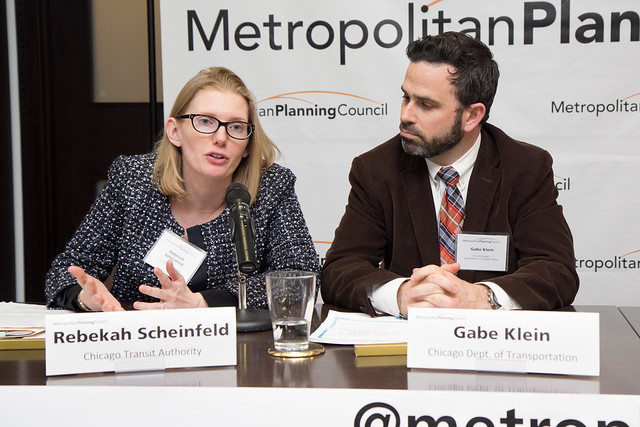
I recently moved to the Windy City from Portland, Oregon, where I had served as a member of the Oregon Bicycle and Pedestrian Advisory Committee at the state level for bike and pedestrian issues. So I came into last Wednesday's meeting of the Mayor's Pedestrian Advisory Council excited to hear the breadth and depth of pedestrian advocacy and projects happening in Chicago. Based on my experience in Oregon, I expected a meeting structured around deliberate conversation and debate. Instead, what I saw was an information session.
In Oregon, I was appointed by the governor to my four-year term in the fall of 2009, and my tenure on OBPAC was marked by a significant shift in the way viewpoints of advocates and members of the committee were incorporated into broader policy change. What had at one time been more of a one-way arrangement, in which Oregon DOT staff came to present information in a "show and tell" format, became a real committee where the governor’s top sustainability and transportation advisors frequently dropped by to pick up ideas. Tabletop nameplates served to create a sense of professionalism and respect. The committee’s later decision to increase the number of meetings from four to six per year increased the stakes for committee member participation and staff preparation.
Sitting back and observing the room on Wednesday, it wasn’t clear to me who was on the committee and who wasn’t. With several presenters and members of the public nestled among the committee, the resulting dynamic was one of indecisiveness. What actions were going to come out of the meeting? Which players in the room were going carry out the action? What were the results of these conversations?
What should be an opportunity to press for changes to the status quo instead felt more like a rote list of ongoing projects and initiatives. We were told about Safe Routes to School projects and grants, the Safe Routes Ambassadors program, snow removal efforts, and pedestrian fatalities, but we did not exchange ideas.
While there is certainly value to informing advocates of current efforts, in Oregon the advisory committee also involved truly advising public agencies. At MPAC, there should be an opportunity for larger ideas and discussions. General questions should be posed of committee members, such as the best way to go about a policy change, which partners to include in reform efforts, or general concerns for pedestrians in the built environment. At the very least, a public comment period, which was conspicuously absent from the agenda, would be a good start.
While Oregon may be perceived as an anomaly in the amount of public process at each level of government, it has taken the concerted efforts of government staff and citizens to make it this way. If you believe in public process, creating a dialogue in which all topics are welcomed and encouraged is but a small step in fulfilling the potential of advisory committees. The result of this approach is more robust, vetted, and longer-lasting solutions.
As an example of what's lacking now at MPAC, surprisingly little was said about pedestrian fatalities, which the committee covered for less than five minutes. Considering that drivers killed two pedestrians in January, it seems that the meeting could have been an opportunity for committee members to address the causes of these deaths and how they can be prevented. But apart from some cursory mentions, there was little discussion of the pedestrian deaths last month.
Almost as sure as the next snowstorm, people will be inconvenienced, injured, or worse, killed while walking in the Windy City. In a room filled with pedestrian advocates, perhaps time would be better spent discussing what more can be done to improve pedestrian safety rather than holding a session dedicated mainly to updating everyone on existing pedestrian programs and improvements.
If MPAC is indeed going to serve as an "advisory" body, it would be great to see more questions being asked of its members about how they will fix the deadly status quo. Given CDOT Commissioner Rebekah Scheinfeld’s background in transportation issues at the Chicago Transit Authority and her desire to move MPAC in the same direction as her predecessor, Gabe Klein, there is hope she will create a stronger sense of urgency. We need bold leadership and strong citizen advisory committees to reach the city’s goal of eliminating traffic fatalities by 2022.




